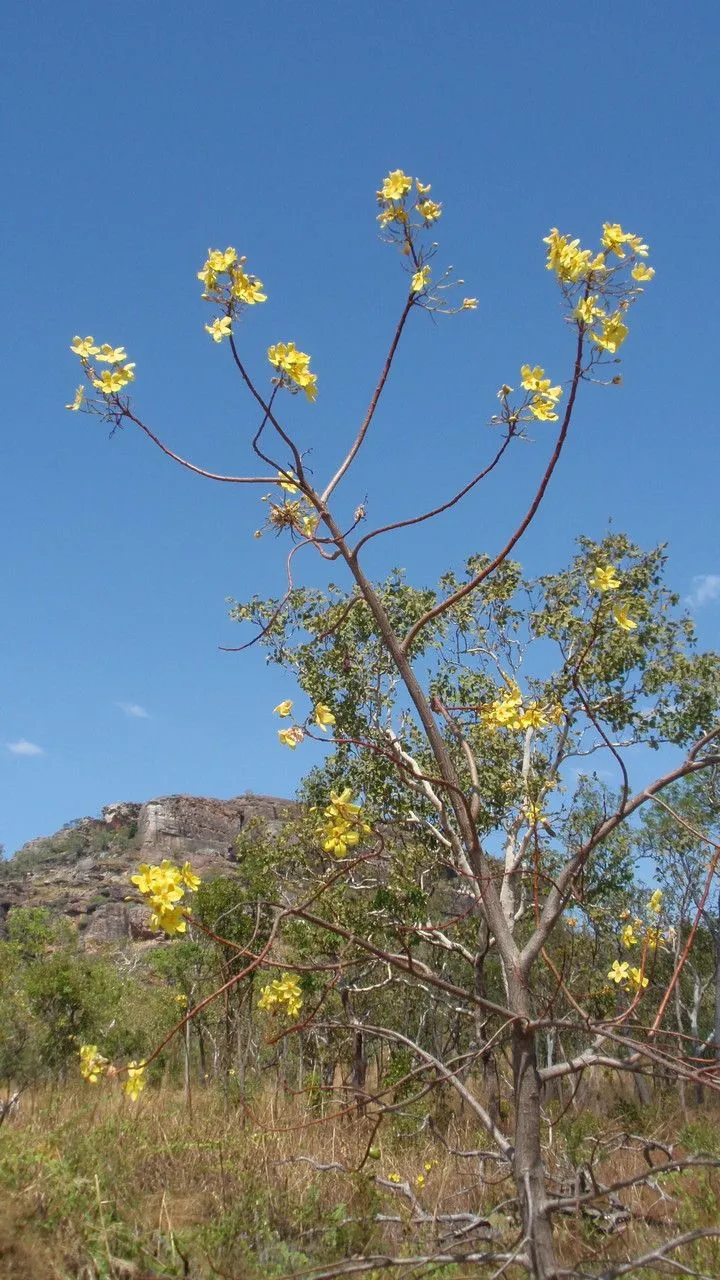
Author: Planch.
Bibliography: London J. Bot. 6: 307 (1847)
Year: 1847
Status: accepted
Rank: species
Genus: Cochlospermum
Vegetable: False
Observations: N. Australia
The Kapokbush, scientifically known as Cochlospermum fraseri, is a captivating plant native to Northern Australia. A member of the Bixaceae family, this species was formally documented in the mid-19th century and can be traced back to Planchon’s contributions in London Journal of Botany in 1847.
Cochlospermum fraseri typically thrives in the arid and semi-arid regions of Northern Australia, where it adds a distinctive touch to the landscape with its striking appearance. The plant is known for its robust growth, often forming a shrub or small tree, and it can reach an average height suitable for thriving in its natural habitat.
The leaves of the Kapokbush are one of its most recognizable features. They are generally broad, lobed, and display a vivid green hue, which provides a sharp contrast to the otherwise dry and sparse surroundings. During the blooming season, the Kapokbush bursts into clusters of bright yellow flowers. These flowers are not only visually appealing but also serve an ecological purpose by attracting various pollinators, including bees and birds.
This resilient plant is widespread across Northern Australia and is well-adapted to the challenges posed by its environment. It commonly flourishes in well-drained soils, often found in open woodlands and grasslands. The adaptation to a variety of soil conditions and climatic variations makes the Kapokbush an important species in its native region, contributing to the ecosystem’s diversity and stability.
The Kapokbush plays a crucial role in its habitat. Its flowers, besides being attractive, are vital for pollination. The plant also serves as an important food source for native wildlife. Furthermore, its presence helps in preventing soil erosion due to its well-established root system, thus maintaining the health of the soil and supporting other plant and animal life in its vicinity.
Historically, Cochlospermum fraseri has been utilized by Indigenous Australians for various purposes. The fibrous nature of the kapokbush has been employed in traditional crafts, including the making of ropes and nets. Additionally, some parts of the plant have been used in traditional medicine, showcasing its versatility and the knowledge embedded in indigenous practices.
In conclusion, the Kapokbush (Cochlospermum fraseri) is not just a plant but a vital component of Northern Australia’s natural heritage. Its vibrant flowers and robust presence underscore the unique botanical diversity of the region, making it a subject of interest for botanists and ecologists alike. The legacy of its documentation by Planchon in 1847 continues to inspire ongoing research and appreciation for this remarkable plant species.
Eng: kapokbush, kapoktree
En: Kapokbush, Kapoktree
Taken Aug 9, 2011 by Daniel Barthelemy (cc-by-sa)
Taken Aug 9, 2011 by Daniel Barthelemy (cc-by-sa)
Taken Aug 9, 2011 by Daniel Barthelemy (cc-by-sa)
Taken Aug 9, 2011 by Daniel Barthelemy (cc-by-sa)
Taken Aug 9, 2011 by Daniel Barthelemy (cc-by-sa)
Taken Sep 28, 2020 by Marie-Angel Chevrier (cc-by-sa)
Taken Aug 9, 2011 by Daniel Barthelemy (cc-by-sa)
Taken Aug 9, 2011 by Daniel Barthelemy (cc-by-sa)
Taken Jun 4, 2022 by Birgitta Tittel (cc-by-sa)
Taken Jul 3, 2022 by de Souza Araújo Ezequiel (cc-by-sa)
Taken Jul 3, 2022 by de Souza Araújo Ezequiel (cc-by-sa)
Taken Aug 9, 2011 by Daniel Barthelemy (cc-by-sa)
Taken Sep 28, 2020 by Marie-Angel Chevrier (cc-by-sa)
Taken Jul 3, 2022 by de Souza Araújo Ezequiel (cc-by-sa)
Taken Jul 3, 2022 by de Souza Araújo Ezequiel (cc-by-sa)
Family: Myrtaceae Author: (F.Muell.) K.D.Hill & L.A.S.Johnson Bibliography: Telopea 6: 402 (1995) Year: 1995 Status:…
Family: Rubiaceae Author: Pierre ex A.Froehner Bibliography: Notizbl. Bot. Gart. Berlin-Dahlem 1: 237 (1897) Year:…
Family: Sapindaceae Author: Koidz. Bibliography: J. Coll. Sci. Imp. Univ. Tokyo 32(1): 38 (1911) Year:…
Family: Asteraceae Author: A.Gray Bibliography: Pacif. Railr. Rep.: 107 (1857) Year: 1857 Status: accepted Rank:…
Family: Fabaceae Author: Medik. Bibliography: Vorles. Churpfälz. Phys.-Ökon. Ges. 2: 398 (1787) Year: 1787 Status:…
Family: Aspleniaceae Author: (Cav.) Alston Bibliography: Bull. Misc. Inform. Kew 1932: 309 (1932) Year: 1932…